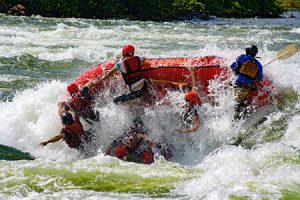Each summer for the past eight years, my wife and I get together with some good friends and take a trip to Wyoming to go whitewater rafting. The first year that we went, we enlisted the services of an experienced guide who helped us successfully navigate the river.
On that first trip, our guide taught us not only how to make it down the river, but how to maximize the excitement without serious mishap. Without a doubt, the most exciting spots on the river are what our guide called “deep holes.”
 A deep hole is where most of the river flow is channeled over several large boulders, which causes the pace of the river to pick up dramatically. As the water passes over the large rock, the water tends to rise slightly before plunging three to six feet. At the bottom, the water curls back with tremendous force causing anything that enters to roll or flip over and meet the incoming water.
A deep hole is where most of the river flow is channeled over several large boulders, which causes the pace of the river to pick up dramatically. As the water passes over the large rock, the water tends to rise slightly before plunging three to six feet. At the bottom, the water curls back with tremendous force causing anything that enters to roll or flip over and meet the incoming water.
When you navigate the river correctly with proper equipment, the adrenaline it creates, with the sudden fall of the raft and then the upward explosion over the curl, is unmatched. If navigated incorrectly, the raft can become caught in the circular motion, flipping over and sending the crew into the icy mountain water where they are at the mercy of the current. This river vortex holds individuals and boats captive to endure repeated spin cycles before spitting them down the river.
It would be foolish for anyone who did not have the proper training and experience to purchase a raft with all the latest features and lead an expedition in whitewater rafting.
The Simulation Vortex
I have known many engineers new to simulation who buy expensive simulation software with all the latest features. They train in the syntax of the software and then try to lead a simulation expedition. These engineers usually have a group of people that they have placed in their boat such as management, co-workers, and they have invited everyone to watch the trip.
At first the waters are calm, the ride seems smooth and enjoyable. They are unaware that around the next turn the water is churning. When encountered, the engineer tends to place all confidence in the expensive simulation software until the simulation vortex flips the boat sending management and co-workers into the icy waters of reality. The project fails, the simulation software is blamed, and management loses all confidence that simulation will provide any benefit.
Tips for Avoiding the Simulation Vortex
How do you gain the simulation experience needed to feel confident that management will give you their blessing and let you steer the raft through the rough patches? There are three things you need:
- Training
- Training
- Training

All kidding aside, let’s take a look at these in order:
1. Training on Management Awareness
The first step of any successful project is to train your management in the benefits of simulation. If you can’t do this, train yourself first. The evidence for the benefits of simulation is overwhelming. Educate yourself, then educate your management.
2. Training on Software Selection
Find the right information on what to look for in simulation software. This can be done by listening to someone with experience (a guide) who has used simulation software in a real situation. The old adage “you get what you pay for” does not hold with simulation software. Look closely at the features and the usability (not ease-of-use) of the software before you buy. Usability is defined as intuitive features or constructs that make the software understandable, powerful, and easy to master. A usable product shortens the learning curve of software mastery and adds productivity to the simulation process. Even if you have all the skills to perform simulation projects, you must have the right tools to get the job done.
3. Training on Simulation Project Management
Get the proper training on simulation project management. Hire a guide to teach you the ropes. Learn to see your first project as one big training exercise. Your guide should work with you during this crucial time, providing training and experience to meet goals. This can include design of experiments, flow charting, data collection and statistical analysis, writing the assumptions document, phased model development, model validation, and simulation output analysis.
The Bottom Line
Every time a simulation project is declared a success, it is the result of correct simulation project management. Software is only a part of the simulation process, therefore, if you want to be successful at simulation you need to prepare and plan for success. There is a saying that I call the 5 P’s; Proper Planning Prevents Poor Performance. Proper planning can only be achieved with proper training and efficiency in all aspects of the simulation process.
With the proper training, you can always avoid the simulation vortex. You’ll turn your simulation projects into rewarding experiences, and make yourself the hero in the process.
Want to learn more?
Do you have unaddressed simulation needs? Please contact us to get a quote on software or consulting services. You might be surprised just how affordable and informative a simulation project can be.
